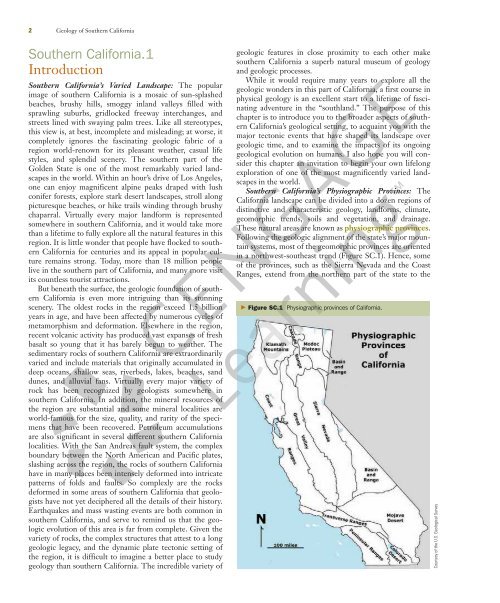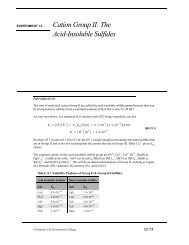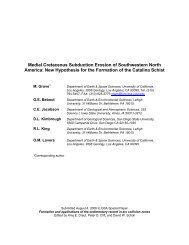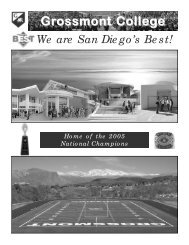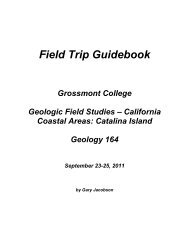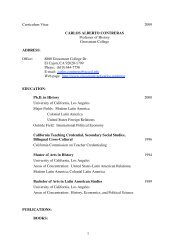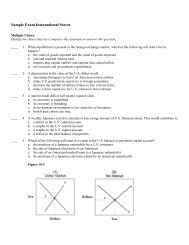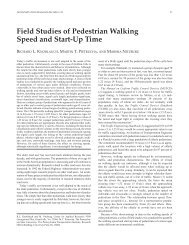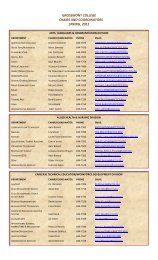Geology of Southern California.pdf - Grossmont College
Geology of Southern California.pdf - Grossmont College
Geology of Southern California.pdf - Grossmont College
You also want an ePaper? Increase the reach of your titles
YUMPU automatically turns print PDFs into web optimized ePapers that Google loves.
2 <strong>Geology</strong> <strong>of</strong> <strong>Southern</strong> <strong>California</strong><br />
<strong>Southern</strong> <strong>California</strong>.1<br />
Introduction<br />
<strong>Southern</strong> <strong>California</strong>’s Varied Landscape: The popular<br />
image <strong>of</strong> southern <strong>California</strong> is a mosaic <strong>of</strong> sun-splashed<br />
beaches, brushy hills, smoggy inland valleys filled with<br />
sprawling suburbs, gridlocked freeway interchanges, and<br />
streets lined with swaying palm trees. Like all stereotypes,<br />
this view is, at best, incomplete and misleading; at worse, it<br />
completely ignores the fascinating geologic fabric <strong>of</strong> a<br />
region world-renown for its pleasant weather, casual life<br />
styles, and splendid scenery. The southern part <strong>of</strong> the<br />
Golden State is one <strong>of</strong> the most remarkably varied landscapes<br />
in the world. Within an hour’s drive <strong>of</strong> Los Angeles,<br />
one can enjoy magnificent alpine peaks draped with lush<br />
conifer forests, explore stark desert landscapes, stroll along<br />
picturesque beaches, or hike trails winding through brushy<br />
chaparral. Virtually every major landform is represented<br />
somewhere in southern <strong>California</strong>, and it would take more<br />
than a lifetime to fully explore all the natural features in this<br />
region. It is little wonder that people have flocked to southern<br />
<strong>California</strong> for centuries and its appeal in popular culture<br />
remains strong. Today, more than 18 million people<br />
live in the southern part <strong>of</strong> <strong>California</strong>, and many more visit<br />
its countless tourist attractions.<br />
But beneath the surface, the geologic foundation <strong>of</strong> southern<br />
<strong>California</strong> is even more intriguing than its stunning<br />
scenery. The oldest rocks in the region exceed 1.5 billion<br />
years in age, and have been affected by numerous cycles <strong>of</strong><br />
metamorphism and deformation. Elsewhere in the region,<br />
recent volcanic activity has produced vast expanses <strong>of</strong> fresh<br />
basalt so young that it has barely begun to weather. The<br />
sedimentary rocks <strong>of</strong> southern <strong>California</strong> are extraordinarily<br />
varied and include materials that originally accumulated in<br />
deep oceans, shallow seas, riverbeds, lakes, beaches, sand<br />
dunes, and alluvial fans. Virtually every major variety <strong>of</strong><br />
rock has been recognized by geologists somewhere in<br />
southern <strong>California</strong>. In addition, the mineral resources <strong>of</strong><br />
the region are substantial and some mineral localities are<br />
world-famous for the size, quality, and rarity <strong>of</strong> the specimens<br />
that have been recovered. Petroleum accumulations<br />
are also significant in several different southern <strong>California</strong><br />
localities. With the San Andreas fault system, the complex<br />
boundary between the North American and Pacific plates,<br />
slashing across the region, the rocks <strong>of</strong> southern <strong>California</strong><br />
have in many places been intensely deformed into intricate<br />
patterns <strong>of</strong> folds and faults. So complexly are the rocks<br />
deformed in some areas <strong>of</strong> southern <strong>California</strong> that geologists<br />
have not yet deciphered all the details <strong>of</strong> their history.<br />
Earthquakes and mass wasting events are both common in<br />
southern <strong>California</strong>, and serve to remind us that the geologic<br />
evolution <strong>of</strong> this area is far from complete. Given the<br />
variety <strong>of</strong> rocks, the complex structures that attest to a long<br />
geologic legacy, and the dynamic plate tectonic setting <strong>of</strong><br />
the region, it is difficult to imagine a better place to study<br />
geology than southern <strong>California</strong>. The incredible variety <strong>of</strong><br />
geologic features in close proximity to each other make<br />
southern <strong>California</strong> a superb natural museum <strong>of</strong> geology<br />
and geologic processes.<br />
While it would require many years to explore all the<br />
geologic wonders in this part <strong>of</strong> <strong>California</strong>, a first course in<br />
physical geology is an excellent start to a lifetime <strong>of</strong> fascinating<br />
adventure in the “southland.” The purpose <strong>of</strong> this<br />
chapter is to introduce you to the broader aspects <strong>of</strong> southern<br />
<strong>California</strong>’s geological setting, to acquaint you with the<br />
major tectonic events that have shaped its landscape over<br />
geologic time, and to examine the impacts <strong>of</strong> its ongoing<br />
geological evolution on humans. I also hope you will consider<br />
this chapter an invitation to begin your own lifelong<br />
exploration <strong>of</strong> one <strong>of</strong> the most magnificently varied landscapes<br />
in the world.<br />
<strong>Southern</strong> <strong>California</strong>’s Physiographic Provinces: The<br />
<strong>California</strong> landscape can be divided into a dozen regions <strong>of</strong><br />
distinctive and characteristic geology, landforms, climate,<br />
geomorphic trends, soils and vegetation, and drainage.<br />
These natural areas are known as physiographic provinces.<br />
Following the geologic alignment <strong>of</strong> the state’s major mountain<br />
systems, most <strong>of</strong> the geomorphic provinces are oriented<br />
in a northwest-southeast trend (Figure SC.1). Hence, some<br />
<strong>of</strong> the provinces, such as the Sierra Nevada and the Coast<br />
Ranges, extend from the northern part <strong>of</strong> the state to the<br />
� Figure SC.1 Physiographic provinces <strong>of</strong> <strong>California</strong>.<br />
Courtesy <strong>of</strong> the U.S. Geological Survey


